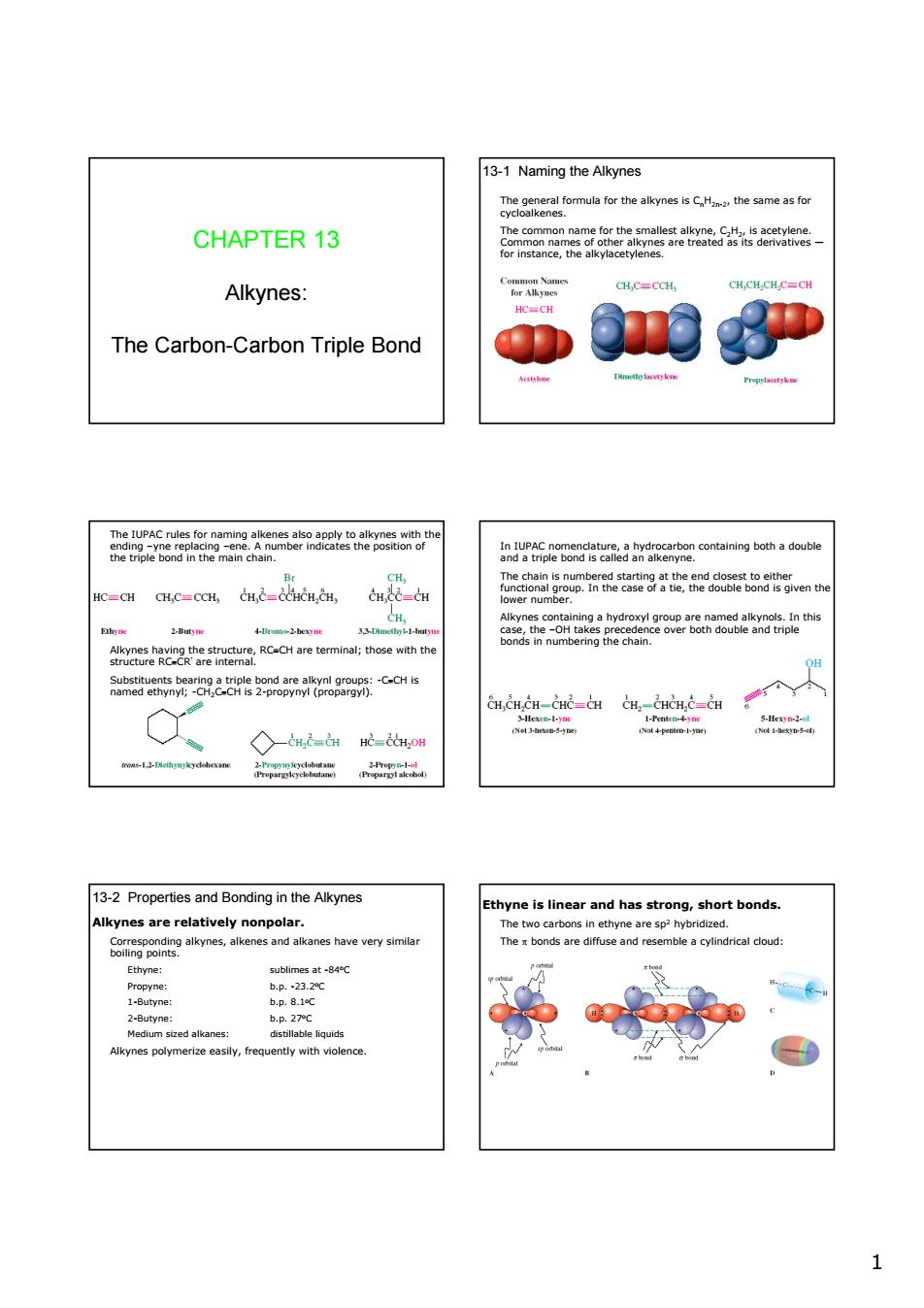
13-1 Naming the Alkynes oul or the alkyntheme CHAPTER 13 Alkynes: CH.C=CCH CH.CH.C-CH The Carbon-Carbon Triple Bond u0 The IUPAC 8ndPSoeocoeetcaegsnmgreceatecoatannobchadoub wc-c Hc-con ene Ceehae02RnetnenrRcc1ar e8aeeg器cos 物 13-2 Properties and Bonding in the Alkynes Alkynes are relatively nonpolar. ,alkenesand alkanes have very sim The bonds are diffuse and resemble a cylindrical cloud at-84C 2 b.p.27C ly wit 1
1 CHAPTER 13 Alkynes: The Carbon-Carbon Triple Bond 13-1 Naming the Alkynes The general formula for the alkynes is CnH2n-2, the same as for cycloalkenes. The common name for the smallest alkyne, C2H2, is acetylene. Common names of other alkynes are treated as its derivatives — for instance, the alkylacetylenes. The IUPAC rules for naming alkenes also apply to alkynes with the ending –yne replacing –ene. A number indicates the position of the triple bond in the main chain. Alkynes having the structure, RC≡CH are terminal; those with the structure RC≡CR’ are internal. Substituents bearing a triple bond are alkynl groups: -C≡CH is named ethynyl; -CH2C≡CH is 2-propynyl (propargyl). In IUPAC nomenclature, a hydrocarbon containing both a double and a triple bond is called an alkenyne. The chain is numbered starting at the end closest to either functional group. In the case of a tie, the double bond is given the lower number. Alkynes containing a hydroxyl group are named alkynols. In this case, the –OH takes precedence over both double and triple bonds in numbering the chain. 13-2 Properties and Bonding in the Alkynes Alkynes are relatively nonpolar. Corresponding alkynes, alkenes and alkanes have very similar boiling points. Ethyne: sublimes at -84oC Propyne: b.p. -23.2oC 1-Butyne: b.p. 8.1oC 2-Butyne: b.p. 27oC Medium sized alkanes: distillable liquids Alkynes polymerize easily, frequently with violence. Ethyne is linear and has strong, short bonds. The two carbons in ethyne are sp2 hybridized. The π bonds are diffuse and resemble a cylindrical cloud:
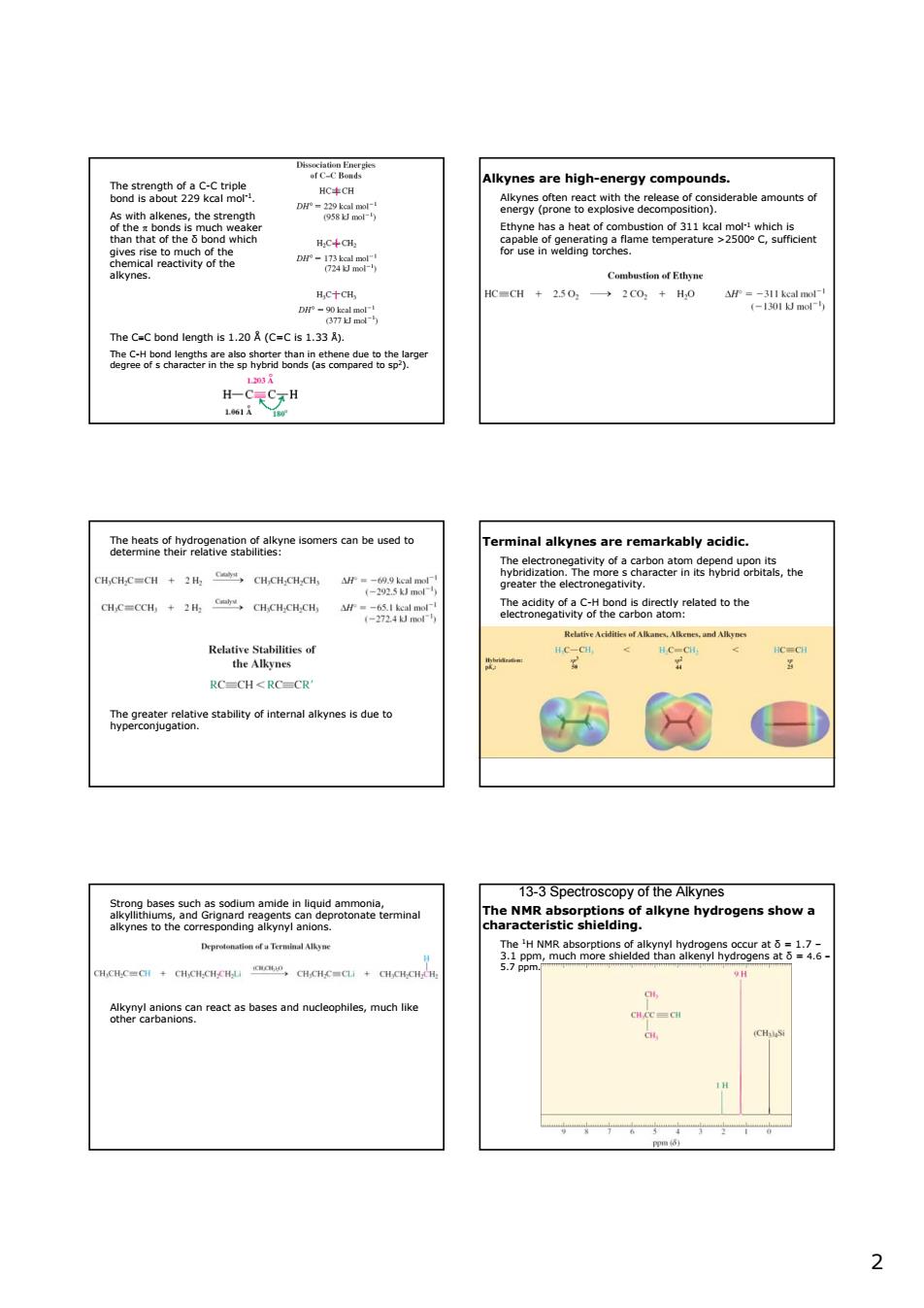
me renth ofCtripe Alkynes are high-energy compounds. o theon =H+250 me Cac bond length is10(C=Cs133) nal alkynes are remarkably acidic. CHCHCECH 2H CHCHCHCH elated tothe RC=CH<RC-CR ggereatiyemaneaen 13-3 Spectroscooy of the alkynes h8aheieainatakynevdrognsshowa 2
2 The strength of a C-C triple bond is about 229 kcal mol-1. As with alkenes, the strength of the π bonds is much weaker than that of the δ bond which gives rise to much of the chemical reactivity of the alkynes. The C≡C bond length is 1.20 Å (C=C is 1.33 Å). The C-H bond lengths are also shorter than in ethene due to the larger degree of s character in the sp hybrid bonds (as compared to sp2). Alkynes are high-energy compounds. Alkynes often react with the release of considerable amounts of energy (prone to explosive decomposition). Ethyne has a heat of combustion of 311 kcal mol-1 which is capable of generating a flame temperature >2500o C, sufficient for use in welding torches. The heats of hydrogenation of alkyne isomers can be used to determine their relative stabilities: The greater relative stability of internal alkynes is due to hyperconjugation. Terminal alkynes are remarkably acidic. The electronegativity of a carbon atom depend upon its hybridization. The more s character in its hybrid orbitals, the greater the electronegativity. The acidity of a C-H bond is directly related to the electronegativity of the carbon atom: Strong bases such as sodium amide in liquid ammonia, alkyllithiums, and Grignard reagents can deprotonate terminal alkynes to the corresponding alkynyl anions. Alkynyl anions can react as bases and nucleophiles, much like other carbanions. 13-3 Spectroscopy of the Alkynes The NMR absorptions of alkyne hydrogens show a characteristic shielding. The 1H NMR absorptions of alkynyl hydrogens occur at δ = 1.7 – 3.1 ppm, much more shielded than alkenyl hydrogens at δ = 4.6 – 5.7 ppm
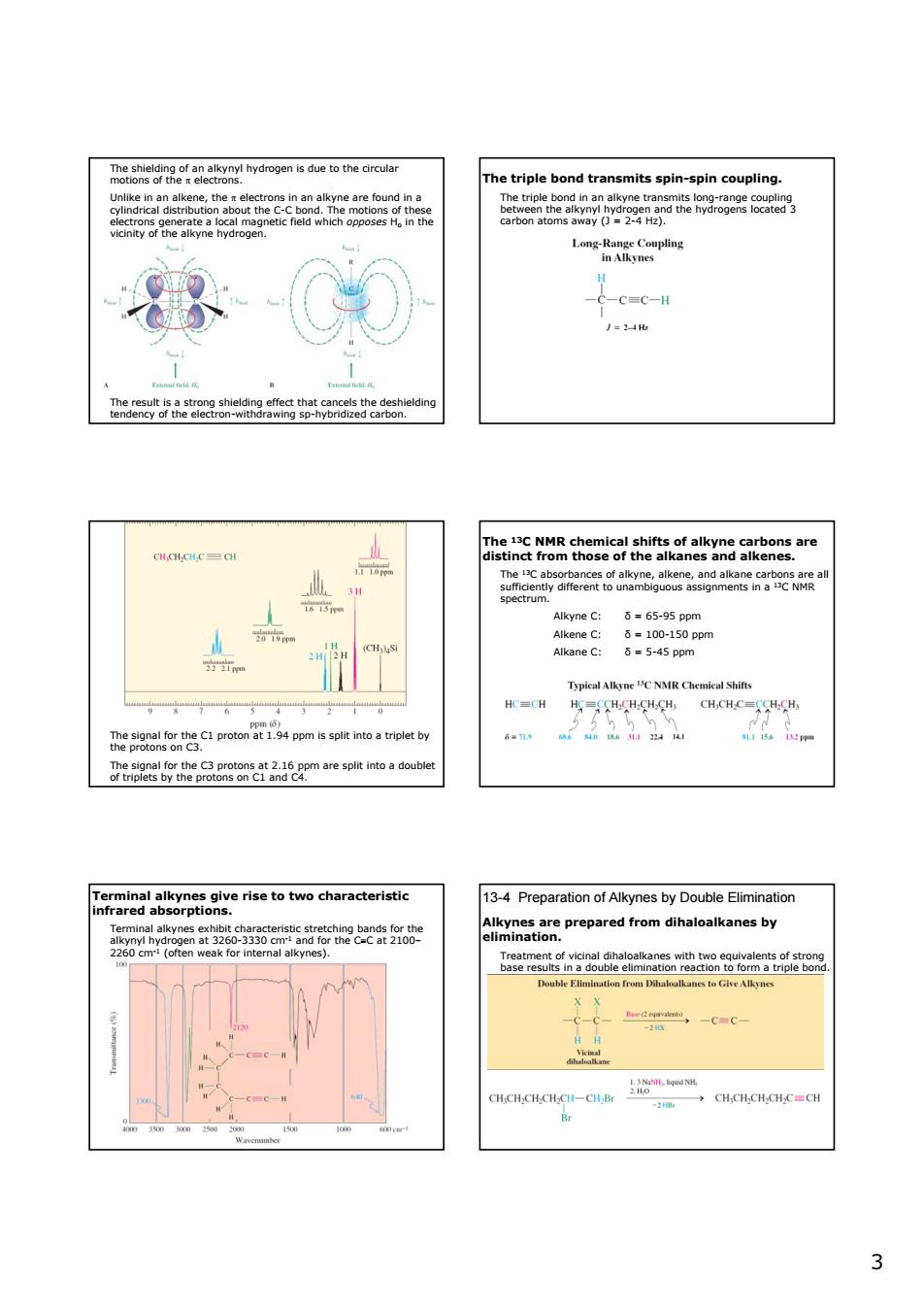
mydogue to the drcular The triple bond transmits spin-spin coupling. Long e Coupling 路00 c-c=C-H aeaaenahrggagntaraetehndng ghanwwRhoeahiatataasaaeasare 5-45ppm HC=CH herotonmpleby ene8ghe8mg8mata2omaresptntoadoubie 13-4 Preparation of Alkynes by Double Elimination re prepared from dihaloalkanes by -CeC- →CH,CH.CH.CHC■C 3
3 The shielding of an alkynyl hydrogen is due to the circular motions of the π electrons. Unlike in an alkene, the π electrons in an alkyne are found in a cylindrical distribution about the C-C bond. The motions of these electrons generate a local magnetic field which opposes Ho in the vicinity of the alkyne hydrogen. The result is a strong shielding effect that cancels the deshielding tendency of the electron-withdrawing sp-hybridized carbon. The triple bond transmits spin-spin coupling. The triple bond in an alkyne transmits long-range coupling between the alkynyl hydrogen and the hydrogens located 3 carbon atoms away (J = 2-4 Hz). The signal for the C1 proton at 1.94 ppm is split into a triplet by the protons on C3. The signal for the C3 protons at 2.16 ppm are split into a doublet of triplets by the protons on C1 and C4. The 13C NMR chemical shifts of alkyne carbons are distinct from those of the alkanes and alkenes. The 13C absorbances of alkyne, alkene, and alkane carbons are all sufficiently different to unambiguous assignments in a 13C NMR spectrum. Alkyne C: δ = 65-95 ppm Alkene C: δ = 100-150 ppm Alkane C: δ = 5-45 ppm Terminal alkynes give rise to two characteristic infrared absorptions. Terminal alkynes exhibit characteristic stretching bands for the alkynyl hydrogen at 3260-3330 cm-1 and for the C≡C at 2100– 2260 cm-1 (often weak for internal alkynes). 13-4 Preparation of Alkynes by Double Elimination Alkynes are prepared from dihaloalkanes by elimination. Treatment of vicinal dihaloalkanes with two equivalents of strong base results in a double elimination reaction to form a triple bond
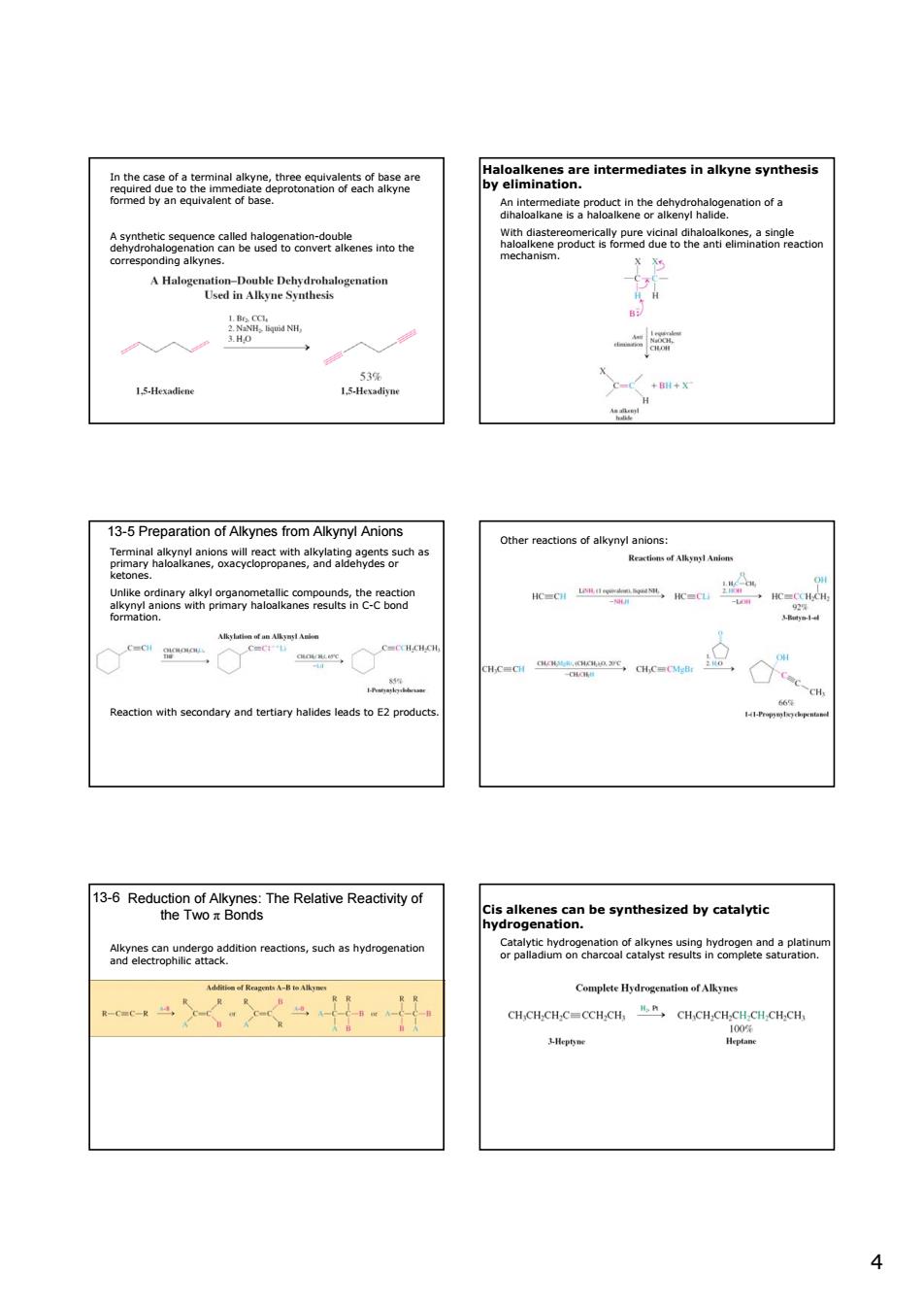
Haloa nes are intermediates in alkyne synthesis ahaoaaasaaeegiaanieno ote 1.5-Hexadiene 13-5 Preparation of Alkynes from Alkymyl Anions 7o372 Reaction with secondary and tertiary halides leads to E2 products 1-RedTheRl Reacvty of yntheed by catalytie gaeo0ncgec4ao reactions,sucas hydrogenatio Complete Hydrugenation of Alkynes 4
4 In the case of a terminal alkyne, three equivalents of base are required due to the immediate deprotonation of each alkyne formed by an equivalent of base. A synthetic sequence called halogenation-double dehydrohalogenation can be used to convert alkenes into the corresponding alkynes. Haloalkenes are intermediates in alkyne synthesis by elimination. An intermediate product in the dehydrohalogenation of a dihaloalkane is a haloalkene or alkenyl halide. With diastereomerically pure vicinal dihaloalkones, a single haloalkene product is formed due to the anti elimination reaction mechanism. 13-5 Preparation of Alkynes from Alkynyl Anions Terminal alkynyl anions will react with alkylating agents such as primary haloalkanes, oxacyclopropanes, and aldehydes or ketones. Unlike ordinary alkyl organometallic compounds, the reaction alkynyl anions with primary haloalkanes results in C-C bond formation. Reaction with secondary and tertiary halides leads to E2 products. Other reactions of alkynyl anions: Reduction of Alkynes: The Relative Reactivity of the Two π Bonds 13-6 Alkynes can undergo addition reactions, such as hydrogenation and electrophilic attack. Cis alkenes can be synthesized by catalytic hydrogenation. Catalytic hydrogenation of alkynes using hydrogen and a platinum or palladium on charcoal catalyst results in complete saturation
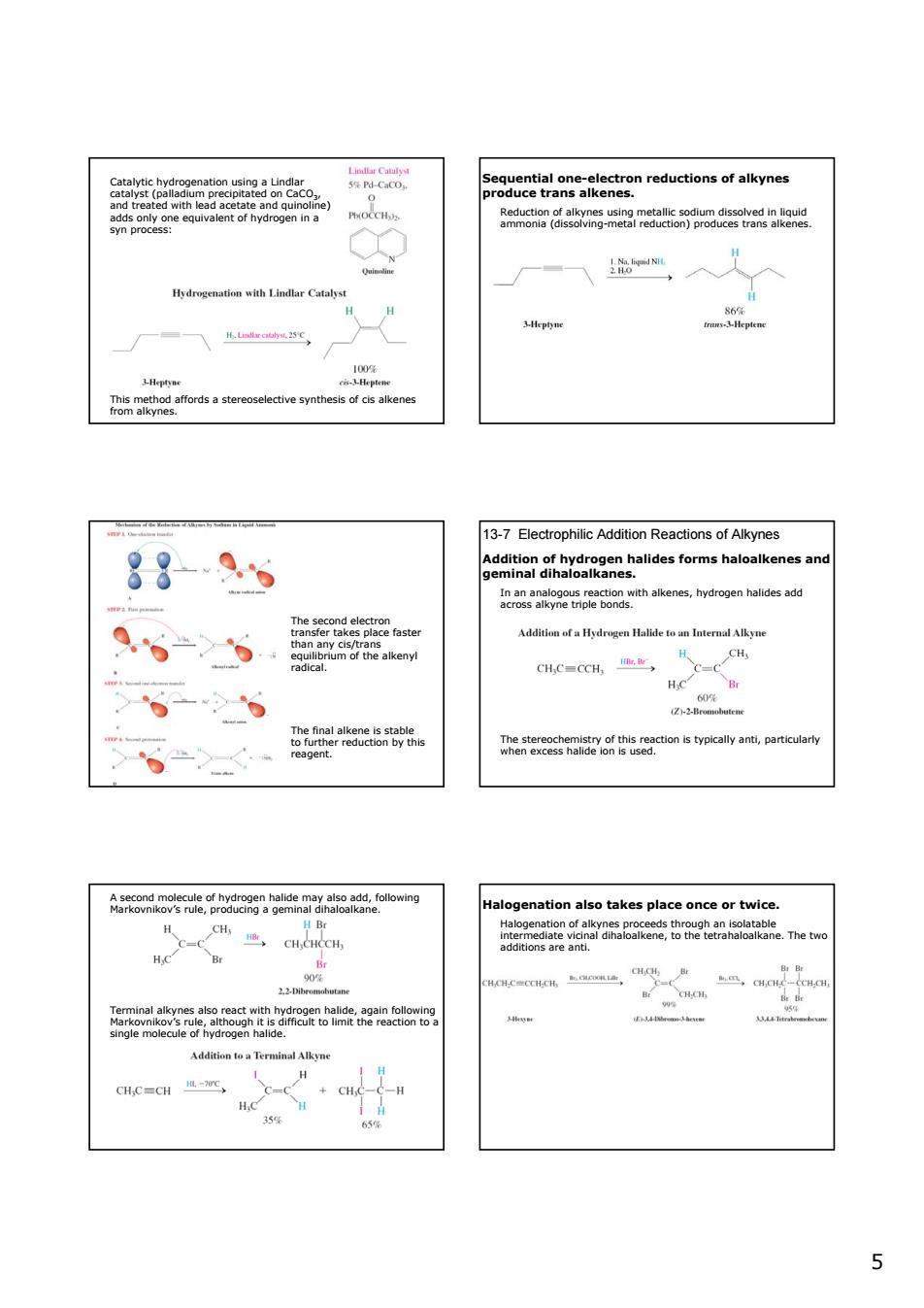
educionof alkynes 8eacedakmgsealTeseo2oeegowaaa 13-7 Electrophilic Addition Reactions of Alkynes 88-9 g8mteifbrcRgahaaesformshaoakensana 96-6 Additin f Halide nterky H.C 6- 器 2g"Ye。oloing Halogenation also takes place once or twice Addition to a Terminal Alkyne ," 5
5 Catalytic hydrogenation using a Lindlar catalyst (palladium precipitated on CaCO3, and treated with lead acetate and quinoline) adds only one equivalent of hydrogen in a syn process: This method affords a stereoselective synthesis of cis alkenes from alkynes. Sequential one-electron reductions of alkynes produce trans alkenes. Reduction of alkynes using metallic sodium dissolved in liquid ammonia (dissolving-metal reduction) produces trans alkenes. The final alkene is stable to further reduction by this reagent. The second electron transfer takes place faster than any cis/trans equilibrium of the alkenyl radical. 13-7 Electrophilic Addition Reactions of Alkynes Addition of hydrogen halides forms haloalkenes and geminal dihaloalkanes. In an analogous reaction with alkenes, hydrogen halides add across alkyne triple bonds. The stereochemistry of this reaction is typically anti, particularly when excess halide ion is used. A second molecule of hydrogen halide may also add, following Markovnikov’s rule, producing a geminal dihaloalkane. Terminal alkynes also react with hydrogen halide, again following Markovnikov’s rule, although it is difficult to limit the reaction to a single molecule of hydrogen halide. Halogenation also takes place once or twice. Halogenation of alkynes proceeds through an isolatable intermediate vicinal dihaloalkene, to the tetrahaloalkane. The two additions are anti